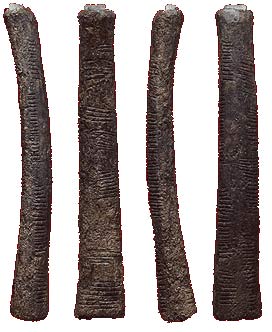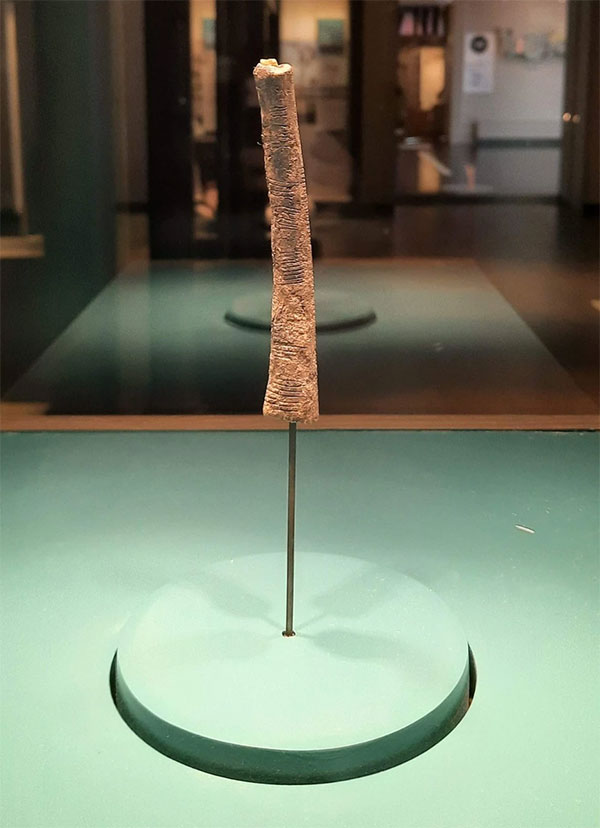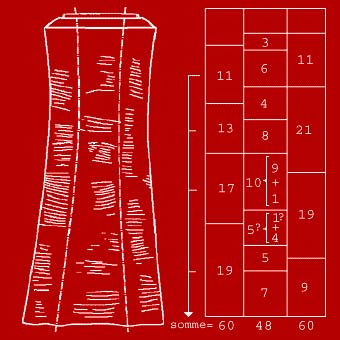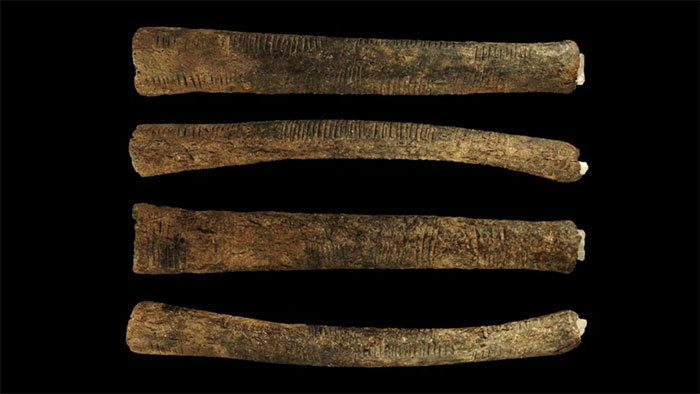The Ishango Bones: Unraveling the earliest evidence for mathematics in human history
Belgian scientists said they have just deciphered the traces engraved on the Ishango bone discovered by a Belgian geologist in Africa half a century ago. Accordingly, the mathematical cradle of humanity is located in Africa.
The Ishango bone , also known as the Ishango stick , dates to nearly 23,000 years before our era. This is the oldest evidence of the application of mathematics in human history. The 10.2 cm long bone belongs to an unidentified animal. At one end of the bone is attached a piece of quartz.
Many engravings on the bones are gathered in an organized manner, divided into groups on 3 columns. Over the years, scientists have invested a lot of time studying the meaning of those engravings. Currently, Ishango’s bones are on display at the Sciences Naturelles museum in Brussels, Belgium.
Belgian archaeologist Jean de Heinzelin de Braucourt found this bone in 1950 on the shore of Lake Édouard in the Ishango region in the Belgian Congo, today the Democratic Republic of Congo, near Ouganda.

 Ishango bone burning (Photo: Research.att.com)
Ishango bone burning (Photo: Research.att.com)
Before that, some people had thought of a kind of moon calendar, an arithmetic game or an abacus from engravings on bones. But the results of a recent study tend to favor the last hypothesis. This is because the second bone, also in Ishango, was discovered by scientists.
Both bones are mathematical objects of a people who did not know how to calculate the decimal system like modern humans, but they knew how to base it on the numbers 6 and 10. Scientists agree I think this is a typical African count.
Jean de Heinzelin was the first to consider this object as an interesting fantasy about the history of human mathematics. He assimilated it to an arithmetic game and gave an arbitrary order to the different columns of signs. The first column is a, the second column is b, and the third column is c and provides a more convincing argument than the previous assumptions.
The author of this important discovery believes that column a is compatible with a basic numbering system of 10, stemming from the fact that the marks engraved on it are grouped like the sequence 10 + 1, 10 – 1, while the column c corresponds to the basic numbering system 20 according to the sequence 20 + 1, 20 – 1. He also admitted that in column b the order of the first odd numbers between 10 and 20 includes 11, 13 and 17, 19. Finally, column c seems to illustrate the method of multiplying and dividing by 2, phoenix This method was used at a stage closest to us in the Egyptian multiplication: 3 x 2 = 6 and 4 x 2 = 8.
The numbers in the two side columns, left column (a) and right column (c) are all odd numbers (a: 9, 11, 13, c: 17, 19 and 21). The numbers in these two columns add up to 60 and the numbers in the middle column (b) add up to 48. These two results are both multiples of 12, which proves that this is a concordance of multiplication and division. Column b seems to illustrate the method of multiplying and dividing by 2 that was used at a period closest to us, the Egyptian multiplication: 3 x 2 = 6 and 4 x 2 = 8.
 Scientists’ explanation (Photo: naturalsciences)
Scientists’ explanation (Photo: naturalsciences)
A decade after discovering the bone, reporter and scientist Alexander Marshack also discovered that the sum of all the numbers in columns a and b is 60 and in column c is 48.
The mathematical symbols of the Ishango bones provide insight into the cognitive development and intellectual abilities of early humans. The ability to engage in abstract mathematical thinking, such as recognizing prime numbers, demonstrates a level of cognitive complexity that goes beyond basic survival instincts. This challenges the traditional view of early humans as purely pragmatic creatures and suggests that they had the cognitive capacity for more complex thought processes.
The Ishango bone is an important archaeological find in the study of the origins of mathematics. It pushes back the timeline of human engagement with mathematical concepts and shows that mathematical thinking has deep roots in human history. By shedding light on the mathematical abilities of ancient civilizations, the Ishango bones help researchers understand the evolutionary trajectory of mathematical thinking and the cultural context in which it developed.
 The carvings on Ishango bones demonstrate a degree of precision and deliberate craftsmanship.
The carvings on Ishango bones demonstrate a degree of precision and deliberate craftsmanship.
The bone’s mathematical symbols may have cultural and symbolic significance for the community that created it. It may be used in religious or ceremonial practices, as a calendar to track important celestial events, or as a symbol of knowledge and power within a community. The craftsmanship and mathematical inscriptions on the bone may have given it a special status, making it a treasured and revered object in its cultural context.
An invaluable archaeological discovery, the Ishango bones remain a focus of research, enriching our understanding of the origins and development of mathematics in human civilization.





